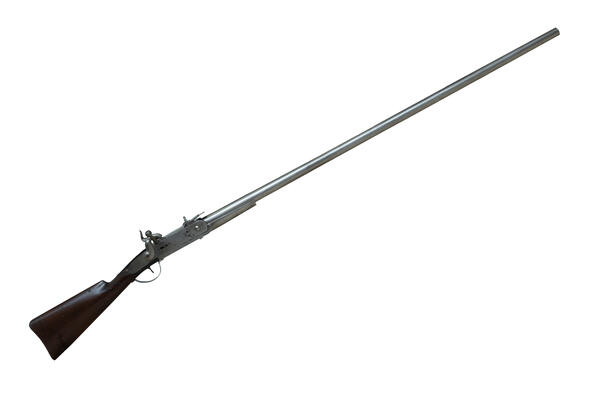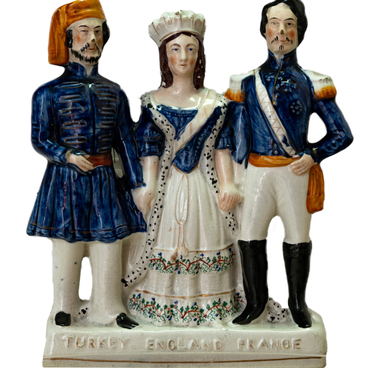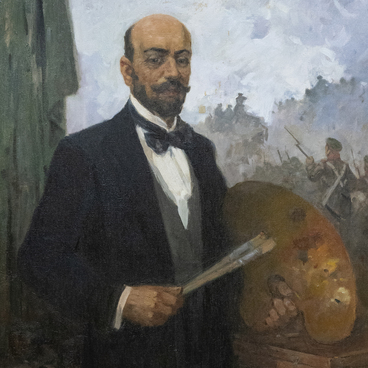The infantry gun at the end of the 20th century was made by an amateur collector Sergey Lazarev. In 1998-1999, together with a scientific expedition, he took part in excavations at the site of the Inkerman battle. Lazarev assembled the gun from the original parts that were found there. In February 2011, he donated the exhibit to the museum.
Lazarev made the butt of the gun and the part that connects it to the muzzle — the rifle stock — of birch wood. It is flexible and resilient material, which is why it was most often used for such weapons. Lazarev attached a leather belt to the gun so that it could be worn on the shoulder.
Initially, these guns were flintlock. Gunpowder was poured onto a special recess in the mechanism — the flash pan. Then they cocked the hammer and pulled the trigger pull. The sharpened flint inside the gun struck a spark, the gunpowder ignited, and a shot was fired.
Lazarev replaced this mechanism with a later primer mechanism. The small cap of these guns — the priming element — contains explosive mixture. Pressing the trigger pull activated the percussive mechanism. From the impact, the explosive mixture ignited and pushed the bullet out of the barrel. Percussion rifles were superior to flintlocks in many respects: it was easier to load them, because there was no need to constantly add gunpowder, and they were less dependent on the weather, since the explosive mixture in the priming element did not get wet.
Under the Emperor Nicholas I, the armament of the Imperial army was improved more than once. Changes were made to pistols and guns in 1826, 1828, 1839, 1844, 1845, 1852, 1854. Beginning in the late 1830s, the government began looking for ways to convert the army to percussion muskets.
Until that moment, the Russian army was armed with flintlocks, which had to be carefully looked after. They often misfired because of worn flint, a carbonized priming hole, or damp gunpowder.
On November 23, 1844, the Emperor Nicholas I ordered in a special decree: “The infantry rifles are to be made percussion in the future”. And on January 9, 1845, the Military Council ordered: “To stop forging new parts for the flintlock system weapons at the factories, unless there is any special, unforeseen difficulty in that”. So, since 1844, all previously existing flintlock guns began to be converted into percussion, or capsule, according to the French model. This model of 1844 was also used when making the infantry gun in the collection of the Museum.
Lazarev made the butt of the gun and the part that connects it to the muzzle — the rifle stock — of birch wood. It is flexible and resilient material, which is why it was most often used for such weapons. Lazarev attached a leather belt to the gun so that it could be worn on the shoulder.
Initially, these guns were flintlock. Gunpowder was poured onto a special recess in the mechanism — the flash pan. Then they cocked the hammer and pulled the trigger pull. The sharpened flint inside the gun struck a spark, the gunpowder ignited, and a shot was fired.
Lazarev replaced this mechanism with a later primer mechanism. The small cap of these guns — the priming element — contains explosive mixture. Pressing the trigger pull activated the percussive mechanism. From the impact, the explosive mixture ignited and pushed the bullet out of the barrel. Percussion rifles were superior to flintlocks in many respects: it was easier to load them, because there was no need to constantly add gunpowder, and they were less dependent on the weather, since the explosive mixture in the priming element did not get wet.
Under the Emperor Nicholas I, the armament of the Imperial army was improved more than once. Changes were made to pistols and guns in 1826, 1828, 1839, 1844, 1845, 1852, 1854. Beginning in the late 1830s, the government began looking for ways to convert the army to percussion muskets.
Until that moment, the Russian army was armed with flintlocks, which had to be carefully looked after. They often misfired because of worn flint, a carbonized priming hole, or damp gunpowder.
On November 23, 1844, the Emperor Nicholas I ordered in a special decree: “The infantry rifles are to be made percussion in the future”. And on January 9, 1845, the Military Council ordered: “To stop forging new parts for the flintlock system weapons at the factories, unless there is any special, unforeseen difficulty in that”. So, since 1844, all previously existing flintlock guns began to be converted into percussion, or capsule, according to the French model. This model of 1844 was also used when making the infantry gun in the collection of the Museum.



